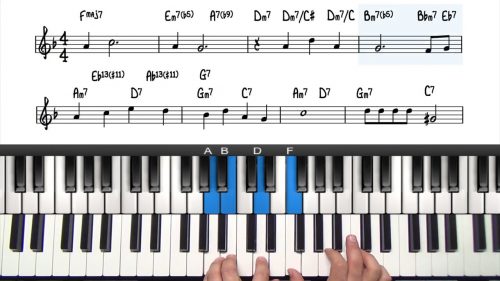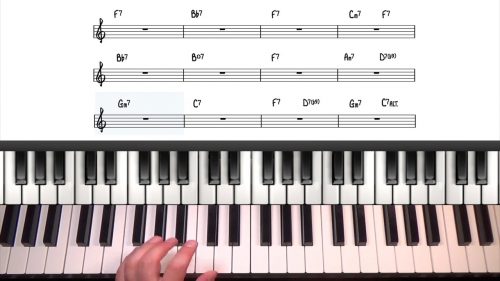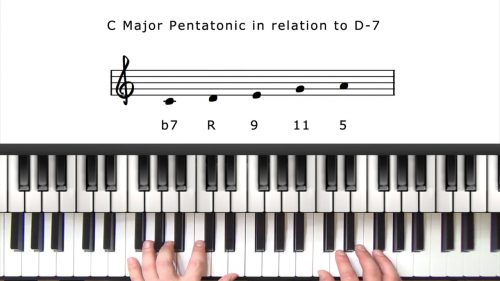Major Scale Fingerings & Technique
Welcome to this lesson on major scale fingerings and technique. In the last lesson we explored the 12 major scales and how they relate to the circle of fifths.
In this lesson we are going to talk about major scale fingerings and proper technique when playing scales on the piano.
Major Scale Fingering Patterns
You will be glad to hear that many of the major scales follow the exact same fingering, or very similar fingering. We are going to demonstrate all of these scales over 2 octaves and we will also discuss the proper technique.
Right Hand Fingering For Major Scales
We will begin with the right hand fingering for the keys which start on white notes. There are 7 keys which start on white notes, we have the keys of C, D, E, F, G, A, & B. All of these keys except the key of F follow the exact same right hand fingering.
Black Key Fingerings For Major Scales
The white keys cover 7 of the 12 notes in octave and the black notes cover 5 of the notes in the octave. So we just have the fingering for 5 black note keys to remember.
The right hand fingering for the scales starting on black keys is not as consistent as for the white keys, but there are some important points to remember which will speed up the memorisation process.
Left Hand Fingering For Major Scales
The left hand fingering for major scales follows a similar relationship to the right hand fingering in that all of the scales starting on white notes follow the same left hand fingering, except the key of B Major.
Notice that the cross over is reversed in relation to the right hand fingering, on the way up the scales in the left hand, the finger goes over the top, and on the way down the thumb tucks underneath.
Left Hand Fingering For Major Black Keys
You will be happy to hear that we finish with a nice simple relationship to remember. All scales that start on black keys follow the same left hand fingering except the key of Gb.
Lesson Downloads
-
Major Scale Fingerings PDF File Type: pdf
Practice Tips
-
When tucking the thumb under on the way up, and when moving fingers over on the way down, this must happen smoothly with flopping, drooping, or twisting of the wrist.
-
The wrist must stay balanced and move smoothly from left to right. Here is an example of bad technique and then good technique.
-
Our fingers should be curved and not straight and form a slight 'cupped' position in the hand.
-
First practice these very slowly and focus on the proper technique as described earlier.
-
With practice you will be able to visualise these scales but use the PDFs if necessary to speed up your memorisation of the scales and fingerings.






Hey Hayden.
I’ve found a lovely arrangement I wanted to share with you of ‘what a wonderful world’
https://music.apple.com/gb/album/what-a-wonderful-world/1570705093?i=1570706049
Look forward to a tutorial of this with you.
Hey Hayden, in reviewing this lesson I noticed the 21:22 chapter title is “LF Fingering White Keys” when I believe it should say “LH Fingering Black Keys”. Cheers, and thanks as always for everything. I feel like I could use Piano Groove for years and still have years of content to learn. I love it. Best, Ashton
Hi there. Is there a pdf for minor scale fingerings too?
Having spent several years playing jazz standards by ear I have to say this fingering discipline is really helpful. The one thing I’d say is that, cognitively, it’s difficult to separate finger numbers from scale numbers. What I struggle with is when Im moving down a scale and want to stay aware of both the proper fingering AND the number of the scale I’m playing 🙂
I am just starting out on this journey. What is the best way to practice scales? When I practice scales should I play with both the right and left hand at the same time or practice each hand separately?
Hi Dr James 👋
Welcome to PianoGroove!
I recommend you to check out our Essentials Practice Guide
This is one of the later lessons in our jazz foundations course.
In this lesson you will see that we take each key individually and complete the following 6 drills:
If you are completely new to learning major scales, I recommend to start with just the keys of C Major, F Major, and Eb Major
Each day try to complete the above 6 drills in just these 3 keys. This will be much more beneficial to you than spending all of your time each day just working on major scales. The idea is that you can attack all of the beginner theory areas in each one of your practice sessions.
When starting with the ‘essentials practice guide’, it may be that you spend all of your time on just 1 of the keys, which is fine, this is a gradual process. In the lesson I recommend grouping the keys together to keep your practice focused. For example, you could spend a week or 2 working on the keys of C Major, F Major, and Eb Major, and then move onto 3 other keys as your focus. The goal is to be able to get through the drills in all 12 keys in the allocated time as I demonstrate in the lesson. This is a gradual process so don’t expect it to happen overnight.
In addition watch the theory lessons in the foundations course so that you start to build an understanding of intervals, triads, 7th chords, and the 251 progression.
Spend half of your daily practice time on the above, and within a few weeks of practice you will be comfortable with at least some of the major keys and basic harmonic building blocks such as triads and 7th chords.
For the other half of your practice time, spend this learning the jazz standard arrangements.
I recommend to start with the below 2 courses:
“Georgia” Bluesy Stride: https://www.pianogroove.com/jazz-piano-lessons/bluesy-stride-piano-beginners/ (F Major)
“Misty” Cocktail Piano: https://www.pianogroove.com/jazz-piano-lessons/cocktail-improvisation-for-beginners/ (Eb Major)
Start at the beginning of these courses and you will learn how the theory is applied in context of jazz standards. As you progress further in these courses you will encounter more advanced theory, and all of this is covered in the upcoming courses, so if it doesn’t make sense at the start, just copy the demonstrations and the full understanding will come with time
I also recommend that you ‘get your toes wet’ in our course on extended chord voicings: https://www.pianogroove.com/jazz-piano-lessons/extended-chords-voicings/ and this will allow you to see what is coming next.
Perhaps spend 2 of every 3 days on the foundations materials, and then each 3rd day of practice you review the theory lessons in the chord extensions course to familiarise your fingers and ears with the shapes and sounds of extended chord voicings.
I hope that helps Dr James and let me know if you have any further questions.
Talk soon, cheers, Hayden
FYI. I believe there is a typo on the 5th chapter title. It should be for the Left hand starting on the black notes (not white notes). Nice video.
Hi Robert,
Thanks for letting me know about this – I have just fixed the typo.
Talk soon, Hayden
Hi Hayden, At the end of this lesson you talk about the “next lesson” that explains the importance of learning the major scales numerically, however the next lesson is about minor scales. Am I missing something?
Hi David,
Thanks for the message. I agree my ending statement should be clearer on the next steps and lessons.
Regarding thinking numerically and learning scales numerically…
If you check out the lessons in module 2 of this course “Basic Jazz Chords”, you will see a lesson on triads and another lesson on 7th chords. In these lessons we identify and construct these chord structures numerically, by taking the notes 1-3-5, or 1-3-5-7 from the associated scale, check out those 2 lessons here:
Triads: https://www.pianogroove.com/jazz-piano-lessons/triads-for-jazz-piano/
7th Chords: https://www.pianogroove.com/jazz-piano-lessons/7th-chords/
After watching these 2 lessons, it should become much clearer why it’s useful to think of scales numerically instead of using the note names.
As you progress onto chapter 3 of this course on “Chord Progressions” you will learn the major 251 progression: https://www.pianogroove.com/jazz-piano-lessons/major-251-progression/
The 251 progression is created from the chords built from the 2nd degree of the scale, the 5th degree of the scale, and the 1st degree of the scale, and so after watching this lesson and working on these chord progressions, your ‘numeric understanding’ of scales will improve and develop.
This numeric way of thinking is not just for the jazz foundations course, if you check out the first lesson in our chord extensions course which is the next course to study after the foundations lessons, again you will see that we use numbers to find the extended chord voicings.
Please check out those lessons David and let me know if it helps to clear things up.
Any further questions I’m here to help.
Talk soon, Hayden
Hi Hayden,
Thank you for your reply. I will study the lessons as you advise.
Many thanks David